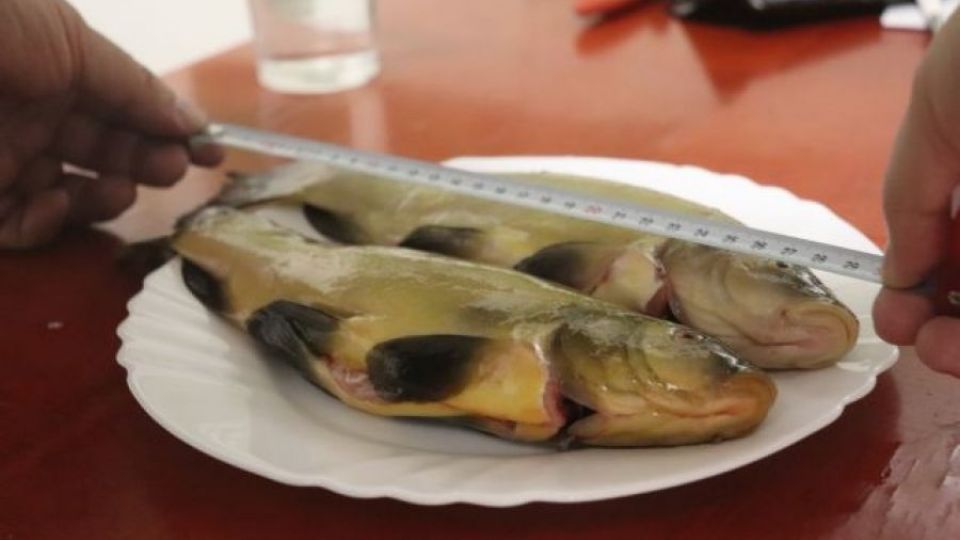Two out of 14 fish samples caught in Prague’s River Vltava slightly exceeded the safe levels recommended by US authorities. For purchased fish samples, five out of 28 did not meet the limit, while one sample exceeded the daily recommended dose by more than five times. This was revealed by a study from Arnika investigating mercury contamination in fish in Prague. The highest levels were found in predatory fish, whose frequent consumption should be avoided, especially by high-risk populations, which include pregnant women and small children. Mercury can damage the nervous and cardiovascular systems in particular.
The mercury intake of the general population comes primarily from fish and shellfish. Arnika therefore commissioned an analysis of 14 fish samples from six locations on the River Vltava, as well as the Motolský and Kyjský Ponds, at the State Veterinary Institute in Prague. The safe levels for mercury intake of 0.22 mg/kg [i] were exceeded in two samples – bream caught in still waters of the River Vltava near Libeň (0.281 mg/kg) and perch from Klecánky, located at the first weir after the outlet of the Central Waste Water Treatment Facility in Podbaba (0.254 mg/kg), where mercury is stored in sediments.
In the second part of the study, a total of 28 samples of sea and freshwater fish purchased in Prague food stores and supermarkets were analysed, five of which did not comply with the safe dose recommended by the US authorities. The highest mercury concentrations were found in monkfish caught in the waters of Denmark (0.242 mg/kg) and tuna steak from Sri Lanka (0.317 mg/kg). Moreover, the mercury concentration in swordfish from Sri Lanka (1.117 mg/kg) exceeded the safe level of mercury by more than five times. The mercury concentrations did not exceed the European safe levels in any sample except for the swordfish purchased at the fish and vegetable market. However, the European limits are considered weak as they do not reflect the potential health risk, especially for vulnerable populations, which include pregnant women and small children. [ii].
Additionally, the study revealed mercury contamination of Prague citizens via an analysis of 10 hair samples from women between the ages of 24 and 53 living in Prague and eating fish regularly. Women of childbearing age are the most vulnerable group, because mercury specifically damages the nervous system in the foetus. The most toxic form – methylmercury – can cross the blood-brain and placental barriers, allowing it to react directly with brain and foetal cells.
Fortunately, the measured values from the women’s hair samples were not high, as they consume fish and seafood less frequently than women in maritime states such as Spain.
“Fish is an important source of omega-3 fatty acids. They are essential for healthy brain development in the foetus and small children. This is not to say that we should remove fish from children’s diets completely, but we should specifically avoid predatory fish. Our findings coincide with the withdrawal of 4500 cans of tuna baby food produced by the Hamé group, ordered by the State Veterinary Authority, because of dangerously increased mercury levels,” explains Karolina Brabcova from Arnika.
The largest sources of mercury pollution in Prague are the cement kiln of Ceskomomoravsky cement a.s. in Radotin and the Communal Waste Incinerator at Malesice and Central Waste Water Treatment Facility in Prague, at Podbaba on the River Vltava. The biggest sources of emissions of mercury into the air are brown coal power plants and local heating systems fuelled by coal.
One of the main sources of mercury contamination in fish comes from industrial activities, including chlor-alkali plants or coal power plants. Toxic mercury travels via the air and water into rivers and oceans while bio-accumulating through the food chain as predators eat other organisms containing mercury and therefore bio-magnifying the mercury burden in their bodies. This way mercury ends up in our bodies primarily from eating certain types of predatory fish.
“By signing the Minamata Convention, the Czech Republic committed itself to restricting mercury emissions into the environment from all sources. It should therefore refrain from expanding coal mining and reject requested exemptions for coal-fired power plants in particular, as they constitute a significant source of mercury emissions globally,” adds Jindrich Petrlik, the head of Arnika’s Toxics and Waste Programme. The Conference of the Parties to the Minamata Convention meets in Geneva on 24th and 25th November 2019. Arnika will participate as an observer to influence politicians in their decisions toward a rapid phase-out of the use of mercury in products and processes, strict control of mercury emissions and the cleaning up of sites contaminated by mercury.
[i] The recommended maximum levels of mercury in fish were calculated from the maximum daily intake level of 0,22 mg/kg of mercury for consumers with average weight of 70 kg and above average fish consumption referring to one fish meal a week. (defined by US EPA)
[ii] The EU limits for mercury in fish are 1 mg/kg for predatory fish and for the other fish 0,5 mg/kg of fresh weight.
Mercury concentrations in fish samples caught in water bodies in the Prague
|
Fish specie |
N. of units in sample |
Location |
Mercury concentrations (mg/kg of raw fish weight) |
|
Roach |
2 |
Podbaba – Roztocká. Vltava River below the outlet from the Central Waste Water Treatment Facility |
0.161 |
|
Bream |
2 |
Libeň. Povltavská. Vltava River |
0.281 |
|
Perch |
3 |
Libeň. still water of Vltava River next to Rokytka Creek estuary |
0.193 |
|
Perch |
1 |
Klecánky. Vltava River |
0.254 |
|
Roach |
1 |
Klecánky. Vltava River |
0.132 |
|
Carp |
1 |
Kyjský Pond |
0.117 |
|
Roach |
1 |
Kyjský Pond |
0.084 |
|
Roach |
2 |
Motolský Pond |
0.053 |
|
Carp |
1 |
Motolský Pond |
0.019 |
Mercury concentrations in fish samples bought in food stores in Prague
|
Specie |
Country/place of origin |
Mercury concentrations (mg/kg of raw fish weight) |
|
Turbot |
Spain / sea (ocean) |
0.037 |
|
Nile Perch |
Tanzania / Lake Victoria |
0.138 |
|
Yellow Fin Tuna |
Oman/ sea (ocean) |
0.317 |
|
Pike |
Czech Republic / Chlumec nad Cidlinou (Pond) |
0.067 |
|
Cod filets |
USA / Pacific Ocean |
0.081 |
|
Rainbow Trout |
Turkey / freshwater fish farm |
0.008 |
|
Rainbow Trout |
Turkey / freshwater fish farm |
0.010 |
|
Rainbow Trout filets |
Turkey / freshwater fish farm |
0.011 |
|
Canned cod liver |
North East Atlantic Ocean |
0.020 |
|
Canned Tuna |
North East Atlantic Ocean |
0.020 |
|
Canned Tuna |
North East Atlantic Ocean |
0.018 |
|
Cod filets |
Bering Sea |
0.012 |
|
Canned Tuna |
Spain / sea (ocean) |
0.269 |
|
Smoked Mackerel |
Northern Sea |
0.125 |
|
Swordfish filets |
Srí Lanka / Indian Ocean |
1.117 |
|
Eel |
Czech Republic / Chlumec nad Cidlinou (Pond) |
0.179 |
|
Monkfish |
Denmark / Sea |
0.242 |
|
Yellow Fin Tuna |
Srí Lanka / Indian Ocean |
0.296 |
|
Haddock filets |
Norway / Atlantic Ocean |
0.042 |
|
Tench |
Czech Republic / Chlumec nad Cidlinou (Pond) |
0.018 |
|
Salmon filets |
Norway / fish farm |
0.018 |
|
Rainbow Trout |
Czech Republic / Chlumec nad Cidlinou (Pond) |
0.029 |
|
Canned Cod liver |
Norway / South East Atlantic Ocean |
0.015 |
|
Canned Tuna |
Ecuador / Pacific Ocean |
0.119 |
|
Canned Cod liver |
Island / Atlantic Ocean |
0.021 |
|
Canned Sardines |
Poland / Baltic Sea |
0.011 |
|
Cod (fish fingers) |
Pacific Ocean |
0.006 |
Mercury concentrations in hair samples of Prague residents
|
Gender |
Age |
Heating Type |
Fish Consumption/ Meals per week |
Smoker |
Smoker living in the family |
Mercury concentrations (mg/kg) |
|
Female |
52 |
Gas heating |
Yes/1-2 |
No |
No |
0.217 |
|
Female |
41 |
Central heating |
Yes/1-3 |
No |
No |
0.300 |
|
Female |
53 |
Electric heating |
Yes |
No |
Yes |
0.102 |
|
Female |
28 |
Gas heating |
Yes/1-2 |
No |
No |
0.250 |
|
Female |
28 |
Central heating |
Yes/1-2 |
Yes |
No |
0.121 |
|
Female |
27 |
Central heating |
Yes/1-2 |
No |
No |
0.507 |
|
Female |
37 |
Combined heating |
Yes |
No |
No |
0.120 |
|
Female |
44 |
Central heating |
Yes |
No |
No |
0.287 |
|
Female |
25 |
Gas heating |
Yes |
Yes |
No |
0.332 |
|
Female |
24 |
Gas heating |
Yes |
No |
No |
0.146 |







